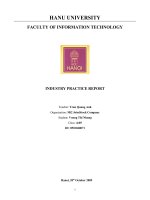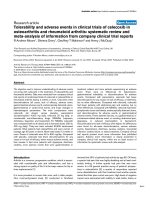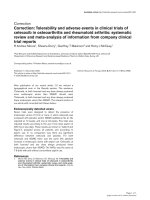Analysis of patent portfolio and financial of information technology management
Bạn đang xem bản rút gọn của tài liệu. Xem và tải ngay bản đầy đủ của tài liệu tại đây (882.31 KB, 84 trang )
ANALYSIS OF PATENT PORTFOLIO AND
FINANCIAL PERFORMANCE OF FIRMS
In Partial Fulfillment of the Requirements of the Degree of
MASTER OF INFORMATION TECHNOLOGY MANAGEMENT
In Computer Science and Engineer
By
Mr. Vu Ba Quang
ID: MITM03010
International University - Vietnam National University HCMC
May 2015
ANALYSIS OF PATENT PORTFOLIO AND
FINANCIAL PERFORMANCE OF FIRMS
In Partial Fulfillment of the Requirements of the Degree of
MASTER OF INFORMATION TECHNOLOGY MANAGEMENT
In Computer Science and Engineer
By
Mr. Vu Ba Quang
ID: MITM03010
International University - Vietnam National University HCMC
May 2015
Under the guidance and approval of the committee, and approved by all its members,
this thesis has been accepted in partial fulfillment of the requirements for the degree.
Approved:
---------------------------------------------Chairperson
-----------------------------------Committee member
---------------------------------------------Committee member
-----------------------------------Committee member
---------------------------------------------Committee member
-----------------------------------Committee member
Acknowledgements
First of all, I would like to express my deepest gratitude to my advisor, Dr.
Nguyen Hong Quang for his support and guidance throughout the research. His
valuable advices led me to the right way to complete the thesis.
During my time of studying at International University, I received lot of useful
knowledge and sharing as well as guidance from my professors and good support
from the Registrar Office. Therefore, I would also like to thank them.
-i-
Plagiarism Statements
I would like to declare that, apart from the acknowledged references, this
thesis either does not use language, ideas, or other original material from anyone; or
has not been previously submitted to any other educational and research programs or
institutions. I fully understand that any writings in this thesis contradicted to the above
statement will automatically lead to the rejection from the MITM program at the
International University – Vietnam National University Ho Chi Minh City.
- ii -
Copyright Statement
This copy of the thesis has been supplied on condition that anyone who
consults it is understood to recognize that its copyright rests with its author and that
no quotation from the thesis and no information derived from it may be published
without the author’s prior consent.
© Vu Ba Quang / MITM03010 / 2012 – 2014
- iii -
Table of Contents
Acknowledgements .................................................................................................... i
Plagiarism Statements................................................................................................ ii
Copyright Statement ................................................................................................. iii
Table of Contents ..................................................................................................... iv
List of Tables........................................................................................................... vii
List of Figures ........................................................................................................ viii
Abstract .................................................................................................................... ix
Chapter One - Introduction ........................................................................................ 1
1. Motivation ......................................................................................................... 1
2. Problem Formulation ......................................................................................... 5
2.1. Unclear relationship between patent portfolio and its performance ............. 6
2.2. Unclear relationship between patent portfolio and financial performance. ... 7
2.3. Limited use of patent indicators to predict financial performance ............... 8
3. Objectives ......................................................................................................... 8
4. Scope................................................................................................................. 9
5. Thesis Structure ................................................................................................. 9
Chapter Two - Literature Review ............................................................................. 10
1. Background ..................................................................................................... 10
1.1. Patent and technology base of a company ................................................. 10
1.2. Financial performance. ............................................................................. 13
1.3. Correlation test. ........................................................................................ 16
2. Related Work .................................................................................................. 17
3. Comparative Analysis of Related Work ........................................................... 19
Chapter Three – Our Proposed Solutions ................................................................. 22
- iv -
1. Overview ......................................................................................................... 22
1.1. Methodology. ........................................................................................... 22
1.2. Building patent portfolio database ............................................................ 23
1.2.1. USPTO Patent data. ............................................................................ 24
1.2.2. Patent database from UC Berkeley. .................................................... 25
1.2.3. Integrate financial data with patent portfolio data …........................... 25
1.3. Patent portfolio indicators......................................................................... 28
2. Spearman correlation between patent portfolio and performance ..................... 30
2.1. Correlation calculation ............................................................................. 31
2.2. Correlation in yearly lags. ......................................................................... 38
2.2.1. Ability to create new technology ........................................................ 38
2.2.2. Innovation history .............................................................................. 39
2.2.3. Innovation rate.. ................................................................................. 40
2.2.4. R&D force.......................................................................................... 40
2.2.5. Summary ............................................................................................ 41
3. Spearman correlation between patent portfolio and financial performance ....... 41
3.1. Correlation calculation.............................................................................. 41
3.2. Correlation in yearly lags.......................................................................... 44
3.2.1. Ability to create new technology. ....................................................... 45
3.2.2. Ability to recognize and acquire existing technology. ......................... 46
3.2.3. Innovation history. ............................................................................. 47
3.2.4. Patent portfolio performance. ............................................................. 47
3.2.5. R&D force.......................................................................................... 48
3.2.6. Technology protection. ....................................................................... 49
3.2.7. Summary ............................................................................................ 49
-v-
4. Artificial Neural Network to predict financial ratio .......................................... 50
4.1. Demonstration of using patent data to predict financial ratios ................... 50
4.1.1. Training.............................................................................................. 51
4.1.2. Network information .......................................................................... 51
4.1.3. Prediction by Observed Chart… ......................................................... 54
4.1.4. Summary ............................................................................................ 55
Chapter Four - Conclusion ....................................................................................... 56
1. Summary ......................................................................................................... 56
2. Future works ................................................................................................... 57
Appendix ................................................................................................................. 58
Appendix A: List of companies in our dataset...................................................... 58
Appendix B: Sample of patent assignment file..................................................... 58
Appendix C: Correlation between patent indicators with patent performance ....... 61
Appendix D: Correlation between patent indicators with financial performance .. 66
References ............................................................................................................... 71
- vi -
List of Tables
Table 1 Correlation result classification ................................................................... 16
Table 2 Methods used in recent researches and our study......................................... 19
Table 3 Indicators used in recent researches and our study ....................................... 19
Table 4 Example of different names of one company ............................................... 27
Table 5 Patent portfolio indicators ........................................................................... 28
Table 6 Correlation result with 2 year lag ................................................................ 34
Table 7 Correlation between inventor indicators with citation indicators.................. 36
Table 8 Correlation between claim indicators with citation indicators ...................... 37
Table 9 Correlation between patent portfolio and financial performance in 2 year lag
................................................................................................................................ 42
Table 10 Neural Network information ..................................................................... 51
Table 11 MLP Model summary ............................................................................... 53
Table 12 MLP Parameter estimates.......................................................................... 53
- vii -
List of Figures
Figure 1: Tangible versus intangible value of the S&P 500 companies....................... 2
Figure 2:. First page of patent “Method for node ranking in a linked” ...................... 11
Figure 3: Analysis steps ........................................................................................... 23
Figure 4: Our data preprocessing ............................................................................. 24
Figure 5: Correlation between the numbers of new patent with citation indicators ... 38
Figure 6: Correlation between the patent age standard deviation with citation
indicators ................................................................................................................. 39
Figure 7: Correlation between patent growth rate with citation indicators ................ 40
Figure 8: Correlation between the average of inventor indicators with citation
indicators ................................................................................................................. 41
Figure 9: Correlation between number of new patents and financial indicator .......... 46
Figure 10: Correlation between number of purchased patents and financial indicator46
Figure 11: Correlation between patent age standard deviation and financial indicator
................................................................................................................................ 47
Figure 12: Correlation between total citation and financial indicator ........................ 48
Figure 13: Correlation between number of inventor and financial indicator ............. 48
Figure 14: Correlation between number of claims and financial indicator ................ 49
Figure 15: Multi-layer perception network with EPS as output ................................ 52
Figure 16: Observed values versus predicted values ................................................. 55
- viii -
Abstract
Meaningful correlation between technological and financial performances is
important to management of technology and innovation. The technological
performance of a firm could be represented by its patent portfolio since the patented
inventions give their owners an exclusive right to exclude others from exploiting and
commercializing them on the market, which highly influences the financial
performance. In this thesis, a new approach is proposed to analyze such a correlation
between the technological and financial performances. Our contributions are threefold. First, our approach proposes that four patent-portfolio indicators highly
correlated to the technological performance of a firm include: patent age, patent
claims, the number of inventors, and the number of patents newly applied for or
purchased. Second, these four indicators give a strong correlation with financial
performance of a firm represented by price to earnings, earning per share, stock price
on the market and other four key financial indicators (liquidity, leverage, profitability,
and valuation ratios). Third, our analysis takes into account the yearly lags of the
technology-finance correlation that happen in reality. Our proposed approach adopts
Spearman correlation coefficient, artificial neuron network and financial ratio
analysis. We experimented on two kinds of datasets: (i) the technology datasets,
including USPTO patents and UC-Berkeley patent datasets, and (ii) the financial
datasets of NASDAQ, AMEX and NYSE stock markets. Such datasets include
322,095 patents from 259 companies specialized in computer technologies in the 35year period (1981 – 2013). Our research outcomes could benefit CEOs, investors and
other stakeholders to design better R&D strategies for increasing their technology
values or to find their investment opportunities.
- ix -
-x-
Chapter One - Introduction
Chapter 1 introduces the foundation of the thesis and provides a background
and the current problems and authors’ objectives to solve them.
1. Motivation
In this new era of technologies, modern companies are moving from
competing with others by decreasing prices or offering additional gifts to researching
and innovating new products and services which can help them to exploit for
commercial advantage. These products are results of practical application of
knowledge which is gained through research and development (R&D) activities.
Utilization of the knowledge during the research phase not only can be used to
introduce new products but also to improve existing ones or optimize processes to
save time and cost. The ultimate aim is to increase businesses’ values and market
share.
In technology industries such as computer hardware, software, and internet
which are evolving day by day due to continuous technological advancements,
businesses must constantly revise their product offerings in order to meet the demands
of consumers and stay competitive. R&D is one solution for them to achieve and
maintain their competitive positions. Taking mobile-phone industry as an example,
since the first iPhone was introduced in the United State, the industry has been
changing significantly and our phones have been evolved from the one with small
screen and keypad to a modern one with large and touchable screen. The top
manufacturers like Apple, Samsung, LG, and Sony...are investing their money in
developing new technologies and products to conquer the market.
Companies may possess many different types of assets including tangible and
intangible assets. Tangible assets can be real estate, office equipment, machines, cash
-1-
and account receivable. These kinds of assets are quite easy to evaluate and often
included clearly on financial reports. However, beside tangible assets, companies also
possess a majority of different intangible assets which have real values and are
important to their success. These can be organizational ability, brand name, trade
mark, and patented technologies or processes.
Figure 1 shows the increasing of percentage of intangible asset of companies
in S&P 500. Its value reached 85% at the beginning of this year, an all-time high for
the years covered by the firm’s research, which extends back to 1975. “Within the last
quarter century, the market value of the S&P 500 companies has deviated greatly
from their book value. This ‘value gap’ indicates that physical and financial
accountable assets reflected on a company’s balance sheet comprises less than 20% of
the true value of the average firm” (James E. Malackowski, personal communication,
June 15, 2010).
Figure 1: Tangible versus intangible value of the S&P 500 companies
( />
-2-
Not only increasing company assets, intangible assets also play an important
role to strengthen owner’s competitiveness and are considered as an early indicator of
stock price performance as Louis Basenese (2012), the founder of the Wall Street
Daily, said “While earnings growth remains a reliable indicator, we’d be well served
to add patent filings to our repertoire, too. It’s an even earlier indicator of stock price
performance.”
In a flat world today, being the first mover to introduce innovative products or
services to market is not enough to gain a competitive advantage. Companies have to
protect their ideas by applying for patents as a legal tool. This tool gives the owners
exclusive rights to solely exploit the patents or allow others to utilize by licensing.
R&D activities indicate that a company is making effort to gain new
advantageous and to make profit, which eventually reflect in the financial
performance measures. There have been already researches on patents as a measure
for technology bases as well as on how to evaluate patent value. However, research on
how the patent portfolio and financial performance is not very large and the utilization
of this correlation is not popular neither.
There are several studies have reported that there is a positive relationship
between innovation and firm performance. Hall et al. (2005), focus on patent citations
to explore whether they can be considered as a measure the market value. They
estimate Tobin’s q equations on the ratios of R&D to assets stocks, patents to R&D,
and citations to patents. And they find that each ratio significantly impacts market
value, with an extra citation per patent boosting market value by 3%. Another study of
Chang, Chen, and Huang (2012) calculated patent H index, current impact index (CII)
and essential patent index (EPI). Then they use panel fixed-effect model to verify if
these indices are positively associated with corporate performance which are
-3-
represented by market value, sales and Return on Equity (ROE). The empirical results
of the fixed effect model indicated that patent H index and EPI were positively
associated with its market value, sales and ROE. That meant that the higher the patent
H index and EPI, the more was its market value, sales and ROE. In contrast, CII was
not positively associated with its market value, sales and ROE. Using data of 479
firms from 1990 to 1997 based on the DTI-Scoreboard, patent data from the “EPO
Worldwide Patent Statistical Database” (PATSTAT) and financial data from Standard
& Poor's COMPUSTAT Global and COMPUSTAT North America databases,
Neuhäusler, Frietsch, and Blind (2011) found that number of patent applications is not
a good predictor of firm performance while family size has a positive association with
Tobin’s q and ROI and average number of forward citations seems to affect market
value positively but not on ROI. Beside the studies of researchers, there are many
products to help users analyze patents data for their very specific purposes. One of
them is Patent Research and Analysis tool of Thomson Reutuers which provide
powerful analysis and visualization tools to gain greater insight. Another famous
patent research and analysis platform is Patent iNSIGHT Pro which includes
advanced text mining algorithms to bring out those insights in minutes which would
erstwhile take days for a researcher. However, most of the tools focus their strength
on patent data analysis to view technology trends, generate patent map report or
identify licensing, research or acquisition opportunities. Little of them can provide an
insight on how the patent portfolio correlates to financial figures or ratios.
In this thesis, the authors try to analyze the relationships between patent
portfolio and financial performance of firms to prove that such relationships do exists.
They will be the framework to build a prediction tools for normal users such as
investors to utilize the patent data in their decision making process.
-4-
2. Problem Formulation
There are a large number of factors can affect the value and competitive
advantage of firms such as business strategy, human resources, market position,
products and services,…Nowadays, people tend to focus on a relatively new factor
which is innovative capacity because it allows the companies to implement new
products or improve existing ones to meet new requirements from customers as well
as to adapt with new market change. However, the successful completion of the
innovation process alone is not enough to secure the benefits gained from R&D. A
firm has to think of how to prevent other competitors to enter its market or mimic its
products and services. In other to do that, it must have protection mechanism provided
by government which patent is one of the most important instruments.
The thesis proposes to solve the problem of analyzing meaningful correlation
between patent portfolio and financial performance by examining the relationship
between indicators of number of patents, patent ages, inventors and patent protection
(patent claims) and patent performance (patent citation) and then between those
indicators and financial performance.
To assess company performance, financial ratio analysis method has been
conducted. It is a method to analyze at company’s financial statements to gain an
insight in financial position of a company in order to form the basis of all investment
decisions. If we find some relationships between patent information and financial
ratios, it means that we can also predict the financial health in the future by using
public patent data.
The following analysis tries to answer the question of how far the result of
R&D and the protection which patents bring can influence the financial performance
and market value of a firm. We will use patent data as a representative of technology
-5-
base and market protection of a firm. Because the value of each patent is different, not
only number of patents in portfolio but also other indicators such as number of
forward citations, number of inventors are employed in the model. In other to
determine the health of a company, we will use stock price and financial ratios which
measure its liquidity, leverage, profitability, and valuation ratios. These ratios can
help to shed a light on how a company is performing in relation to key measures of
business success.
The data analysis comprises 3 problems as following:
1. Unclear relationship between patent portfolio and its performance.
2. Unclear relationship between patent portfolio and financial performance.
3. Limited use of patent portfolio to predict financial performance.
The technological performance of a firm could be represented by its patent
portfolio since the patented inventions give their owners an exclusive right to exclude
others from exploiting and commercializing them on the market, which highly
influences the financial performance
2.1. Unclear relationship between patent portfolio and its performance.
Patent portfolio is the result of R&D activities of companies. However, the
relationship between these indicators with patent performance is not very clear.
Knowing this relationship, the board of management can propose a strategic to
improve their portfolio performance and its value.
Citation to prior art is an indicator of the importance of the prior art to
subsequent inventions. The more citation a patent receives, the more significant it is
measured. In order to evaluate the efficiency of R&D activities, researchers and
management board usually use patent data. The innovation capabilities of companies
are often measured by some indicators. Basically, we have patent count as an outcome
-6-
of R&D performance. However, this figure is somewhat noisy because not all patents
have the same value or technology strength. Some researchers suggest that among
various indicators, patent citation is one of the better to demonstrate patent portfolio’s
value and patent quality. Because when applicants submit new patents, they and
examiners must find and cite older patents which anticipate or be similar to the new
inventions. If we stand at the site of cited patents, these citations are forward citations.
If a patent is highly cited (i.e. cited in 5, 10, or more subsequent patents), then that
patent is likely to contain an important technology which later patents are built on.
Among patent indicators, there are some depends on R&D activities, R&D
team or strategy of companies such as number of patents, patent age, number of
inventors, and number of claims. These indicators are dependent on companies and
might not reflect the values of patent portfolio. Solving this problem may give us a
better understanding on how patent portfolio performance or value is related to the
portfolio characteristics.
2.2. Unclear relationship between patent portfolio and financial
performance. Companies spend money in R&D activities which is transformed into
new products, processes, and services in the future. The ultimate purpose of these
activities is to gain more revenue and benefit and that is also what most investors
want. To choose a stock to invest, they normally consider price and valuation or
evaluate financial health but little of them pay attention to the innovation aspect.
The value and performance of firms depend on a various factors such as
business strategy, human resources, market, products and services. In addition to this,
innovative ability is also very important because it allows firms to renew their
products and services to adapt with constantly changing market or to compete with
other companies. It is said that increased innovative capability can help to improve the
-7-
competitive ability and as a result, leads to an increasing in company revenue and
value.
Calculating the correlation coefficients between patent portfolio figures and
financial ratios can provide us an insight to the relationship between the 2 sets of
information. Although the correlation does not prove that it is a cause-effect
relationship, knowing the trend of the patent portfolio figures which can be calculated
using public data can help to predict the trend of financial performance
2.3. Limited use of patent indicators to predict financial performance.
Solving problem 2 may give us the results that there are indicators have strong,
medium, weak or no relationship with financial performance. It means that we can use
indicators which strong, medium and even weak indicators to build a model to predict
future values of them. If we can do that, investors now have additional tool to help
them to make decision on choosing the right companies.
For average investors, it can be a challenge to select the right stocks on the
market to buy. There are some characteristics which they can pay attention to such as
business model, financial performance, dividend paid, and market trend (Alexander,
Raznick, & Bedigian, 2012) …However, little of them analyze patent data to invest
because the lack of an appropriate tool to give such information and help them to
make decision.
3. Objectives
The aim of our study is to solve above 3 problems. We will focus on
information technology firms which are listed on NASDAQ and NYSE stock markets
of USA because in the new “knowledge economy” era, they are among the fastest and
the most innovative companies and the way this industry has changed over the last
half century. Specifically, we test for the relationship among patent portfolio variables
-8-
such as patent count, patent citations, patent age, citation age, and inventor and firm
financial positions.
4. Scope
The scope of this thesis focuses on analysis of patent portfolio and financial
performance of firms. First, we analyze the correlation of patent count, patent age,
patent claims, and inventor figures to the patent performance which can be indicated
by citations. Then we continue to analyze the correlation of those patent portfolio
indicators with financial ratios including liquidity, leverage, profitability and
valuation ratios. However, the analysis does not aim to explain a cause-and-effect
relationship between them because patent portfolio may not have a direct influence on
financial performance and we need further tools and analysis to explore it.
5. Thesis Structure
In chapter 1, we introduce the motivation of doing this thesis and reveal the
problems we solve together with thesis objectives and scope.
Chapter 2 is the literature review. This is where we get an overview on the
problems and gain a background. Related works of other researchers are presented
here. The main purpose of this part is to provide the meanings of patent portfolio
indicators and financial ratios which are used in the analysis as well as some related
prior arts.
Chapter 3 is where we discuss our solutions and results when we solve
problem 1, problem 2, and problem 3.
Finally, chapter 7 presents the conclusion of my thesis report and proposes
future work.
-9-
Chapter Two - Literature Review
1. Background
1.1. Patent and technology base of a company. A patent, firstly, is a legal
tool having technical claim(s) which describes a technical invention such as a new
device, process, system, or method. According to The United States Patent and
Trademark Office (USPTO), an agency of the U.S. Department of Commerce, patent
for an invention is the grant of a property right to the inventor and the right conferred
by the patent grant is, in the language of the statute and of the grant itself, “the right to
exclude others from making, using, offering for sale, or selling” the invention in the
United States or “importing” the invention into the United States.
In order to register for a patent, inventor(s) normally start with filing an
application. The application should include description of the invention, the
implementation, and a collection of claims with the inventor(s) want to have. The
claims, which are one of the most important parts of patent, define, in technical terms,
the extent, i.e. the scope, of the protection conferred by a patent. This application then
is filed in the country where inventor(s) apply patent. After that, they have one year
decide whether they want to expand the application internationally (it is called patent
family). At the lasted 18 months after first filing, the patent application can be
published. It means that it is widely and freely accessible by anyone.
Figure 2 is an example of a patent named “METHOD FOR NODE RANKING
IN A LINKED DATABASE”. In the first page, there are patent number, publication
date, name, inventor(s), assignee(s), prior patents which it cites and the abstract.
- 10 -
Figure 2:. First page of patent “Method for node ranking in a linked”
The patent application and patent publication include a header with show
name and address of the inventor(s), the assignee(s), the country of origin, filing date
- 11 -
and the state of the art citations (citations which the inventor(s) or the of lawyer of
Patent Office make). In addition to this, there are the details of innovation so everyone
can access for free. All the patent data make up a very rich resource to study about
company technology development, technology strategic as well as result or R & D.
Moreover, the data are free and available for being analyzed.
The product cycle model places a foundation for the idea that technology can
drive the long-term development of market shares. This theory assumes a variety of
ability to exploit new technologies among different entities (Dosi, Pavitt, & Soete,
1991). In addition, it implies that a follower will need time and costs to imitate and
absorb new technology to apply for his products or services. These conditions mean
that innovative products will make monopoly of the market in a period of time before
the followers can catch up. Consequently, firms developing new products or services
using superior technology can take a large share of the market and gain more benefits
than others. To protect themselves from being imitated by other competitors, firms
usually public their technologies to apply for patents. Therefore, patent is one of the
most important intangible assets which can be related to financial performance.
This thesis aims to find out which of these indicators are related to financial
ratios and are applicable for the evaluation of a company value. Although total patents
in a portfolio is direct result of R&D activities, not all patents have the same
economic or technological value so only patent counts does not give us an accurate
view on firm’s technological basis. Therefore, many other indicators have been
calculated and proposed to asset many aspects of patent portfolio. Of course not all of
them have the same impacts on financial performance, some may have strong impact,
some may have slight impact or not at all.
- 12 -
1.2. Financial performance. When people started to have share markets to
buy and sell securities of listed or unlisted companies, they also began to assess
company performance by analyzing financial ratio.
Ratio analysis is one of the most popular and widely used tools of financial
analysis. A ratio is a relation between two quantities. Although it is simple to
calculate a ratio, it may be complex to interpret the outcome. To be meaningful, a
ratio must refer to an economically important relation. For example, there is a direct
and crucial relation between an item’s sales price and its cost. Accordingly, the ratio
of cost of goods sold to sales is important.
Analysis of financial ratios can help stakeholder like creditors, investors,
regulator, or manager to find out the financial soundness of an organization. For
example, CEOs may look into financial ratio reports to get clues for their strategic
changes in business investment or financial activities. They also analyze competitors
to evaluate profitability and risk.
D’Amato (2010) proposed top 15 financial ratios for investors to consider.
Below are selected ratios to be used for the analysis:
Liquidity ratio: liquidity ratios indicate whether a company has the ability to
pay off short-term debt obligations (debts due to be paid within one year) as they fall
due. Generally, a higher value is desired as this indicates greater capacity to meet debt
obligations.
• f1 = Current Ratio: The Current ratio measures a company’s ability to repay
short-term liabilities such as accounts payable and current debt using short-term
assets such as cash, inventory and receivables. Another way to look at it would be the
value of a company’s current assets that will be converted to cash over the next
- 13 -









